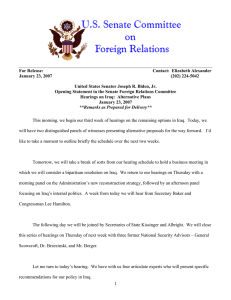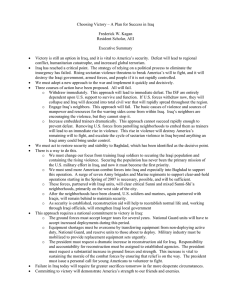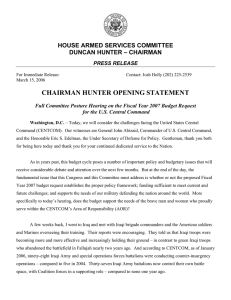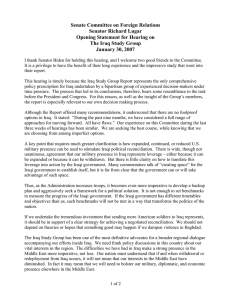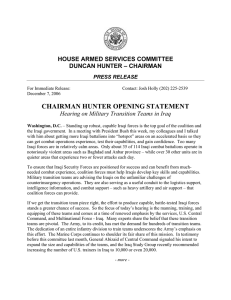women’s organizing and the conflict in Iraq since 2003
advertisement
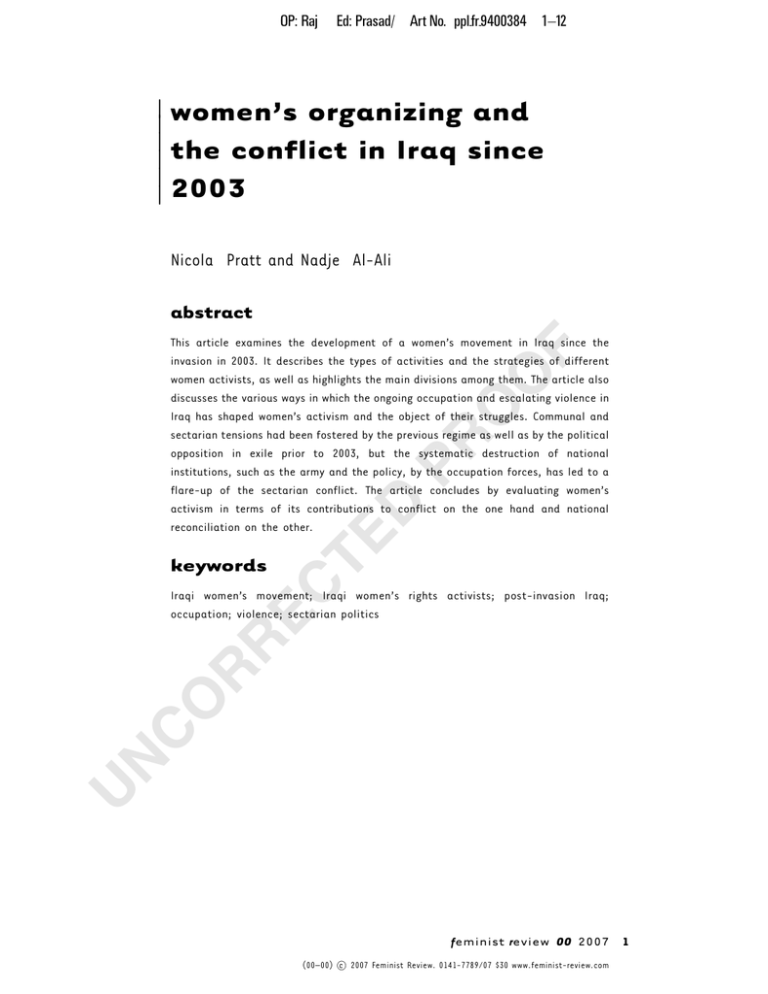
OP: Raj Ed: Prasad/ Art No. ppl_fr_9400384 1^12 women’s organizing and the conflict in Iraq since 2003 Nicola Pratt and Nadje Al-Ali abstract EC keywords TE D PR O O F This article examines the development of a women’s movement in Iraq since the invasion in 2003. It describes the types of activities and the strategies of different women activists, as well as highlights the main divisions among them. The article also discusses the various ways in which the ongoing occupation and escalating violence in Iraq has shaped women’s activism and the object of their struggles. Communal and sectarian tensions had been fostered by the previous regime as well as by the political opposition in exile prior to 2003, but the systematic destruction of national institutions, such as the army and the policy, by the occupation forces, has led to a flare-up of the sectarian conflict. The article concludes by evaluating women’s activism in terms of its contributions to conflict on the one hand and national reconciliation on the other. U N C O R R Iraqi women’s movement; Iraqi women’s rights activists; post-invasion Iraq; occupation; violence; sectarian politics feminist review 00 2007 c 2007 Feminist Review. 0141-7789/07 $30 www.feminist-review.com (00–00) 1 introduction 1 This paper is based on research conducted in the UK, USA, Jordan and Iraq among women activists, practitioners in international organizations and NGOs, as well as government officials, for a larger project, entitled ‘the role of women and gender in the political transition in Iraq’, and funded by a grant from the British Academy. The authors wish to thank the two anonymous reviewers for their very useful comments on an earlier version of this article and the support and encouragement of Amal Treacher. TE D PR O O F The ongoing conflict in Iraq and escalating violence since the invasion in 2003 has unfolded against the backdrop of a society and an economy decimated by over a decade of comprehensive sanctions, previous wars and militarization, in addition to a civil society destroyed by decades of brutal dictatorship (Sluglett and Farouk-Sluglett, 2001; Dodge, 2005; Al-Ali, 2007).1 Communal and sectarian tensions were fostered by the previous regime as well as by the political opposition in exile prior to 2003, but the systematic destruction of national institutions, such as the army and the police, as well as other decisions taken by the occupation authorities, have led to a rapid expansion in communal, tribal and sectarian religious identities and, more significantly, their incorporation into political structures and institutions emerging since the US-led invasion (Dodge, 2005; Herring and Rangwala, 2006). Various political groups, including the former opposition in exile that dominate the central government, as well as those that have formed to resist the occupation and/or central government, have each targeted women and gender relations, through measures ranging between legislation and the use of physical violence, as part of their political projects to gain authority (Al-Ali and Pratt 2006, 2007). It is within this context of occupation, fragmenting authority, competing visions of the political future of Iraq, growing conservative gender ideologies, militarization and widespread violence, including different forms of violence against women, that Iraqi women activists, both inside Iraq and from the diaspora, organize. O R R EC In this article, we will examine the development of the women’s movement in Iraq since 2003. We will describe the types of activities and the strategies of different women activists, as well as highlight the main divisions. The article also discusses the various ways in which the ongoing conflict in Iraq has shaped women’s activism and the object of their struggles. Finally, we will attempt to evaluate women’s activism in terms of its contributions to national reconciliation. C creation of women’s organizations after the fall of the Ba‘th regime U N Women’s organizations have existed in Iraq ever since the creation of the Iraqi state under the British mandate in 1920. They were formed by the wives of the elite who embraced the idea of ‘the new woman’ and established the first Iraqi women’s movement entitled the Women’s Awakening (Nahda al-Nisa’). Women activists at the time mainly engaged in charity work, but also advocated for women’s education, leading to the establishment of the first women’s college in Iraq in the 1930s. During the 1930s, women’s associations set up charitable organizations, including shelters for orphans and health centres, to address the growing ‘social question’ and lack of welfare provision by the state (Kamp, 2003). 2 feminist review 00 2007 women’s organizing and conflict in Iraq 2 The name was changed in 1961 to the Iraqi Women’s League (Rabitat al-mara’ al‘iraqiya). The movement for women’s rights gathered momentum in the 1940s and 1950s as part of the revolutionary movement against the monarchy and continuing British influence over Iraqi politics. In the early 1950s, the League for the Defence of Iraqi Women’s Rights (Rabitat al-difa‘ ‘an huquq al-mara’)2 was established by female members of the Iraqi Communist Party and quickly began to gain influence and following. The League contributed to the passage of a unified personal status code in 1959, which was regarded as a progressive step for women’s rights. During the post-revolutionary years (1958–1963), the Iraqi Women’s League played an important role as a vehicle for reforms and modernization. D PR O O F Women’s public organizing was practically eliminated under the regime of Saddam Hussein, except for the Ba‘th-sponsored General Federation of Iraqi Women (Ittihad al-‘am li-nisa’ al-‘iraq), although some women continued to participate in underground movements linked to opposition political parties. The creation of the safe haven in the Kurdish north of Iraq in 1991 enabled Kurdish women, who already had a long history of activism within political parties, to increase their involvement through participation in women’s unions, women’s organizations and groups not linked to political parties. For women in the centre and south of Iraq, the toppling of Saddam Hussein in 2003 represents the major turning point in the creation of new organizations and groups, including women’s groups and networks. U N C O R 3 Although Decree 137 was overturned, it found its way unto the current constitution in the form of Article 41. This article does not explicitly overturn the unified personal status code but stipulates that personal status issues will be determined by each religious sect, thereby giving authority to religious leaders to define laws according to their beliefs and R EC TE Women’s organizations inside Iraq are simultaneously involved in trying to address practical needs while pursuing more strategic lobbying and campaigning. In terms of ‘strategic’ interests, women have mobilized to protect and to further women’s rights and participation in public life. In particular, they have campaigned (1) against attempts to replace the relatively progressive personal status law governing marriage, divorce and child custody with a more conservative law (Decree 137 issued by the Interim Governing Council at the end of 2003, and Article 41 of the new constitution, ratified in 2005 but that is under review for reasons of national reconciliation)3; (2) to include a women’s quota of elected representatives in central, regional and local government; (3) against Islamist encroachment by political parties and militias; (4) to limit the constitutional role of Islam to include constitutional guarantees that legislation complies with international conventions, including Convention on the Elimination of all Forms of discrimination against women (CEDAW); and (5) against the targeted assassinations of professional women and women rights activists. In terms of ‘practical’ interests, Iraqi women’s groups have organized training for women in vocational skills and income-generation activities, from bee-keeping to tailoring, as well as providing healthcare services, such as mobile clinics, and humanitarian relief to women and their families. In the wake of the fall of the Ba‘th regime, hundreds of women’s organizations mushroomed in the centre and south of Iraq, adding to the already significant Nicola Pratt and Nadje Al-Ali feminist review 00 2007 3 numbers in the Kurdish region, such as Al-Amal, Women Empowerment Organisation, Rewan Women Centre, as well as the women’s unions linked to different political parties in the Kurdish region. While there are no reliable statistics available, all observers are in agreement that the number of new civil society organizations, including NGOs and political parties, formed in the aftermath of the invasion reaches into the hundreds. Of these, a significant number were women’s organizations, such as the National Council of Women, the 1,000 Women’s Conference, the Society of Iraqi Women for the Future and the Iraqi Independent Women’s Group, to mention only a few. As one NGO worker who had been in Baghdad in the immediate aftermath of the fall of Saddam, told Nicola, ‘Iraqi women’s organizations got themselves organized much faster than anyone else’. N C O R R EC TE D PR O O F The majority of women activists we interviewed were motivated by real needs on the ground combined with a desire to take advantage of newly acquired freedoms of association, rather than the availability of funding from US and other governmental/non-governmental agencies. Indeed, initially following the fall of the Ba‘th regime, ‘there were so many people [in US government agencies] talking about the importance [of women’s participation] that it was hard at first to recognize that few of them had any resources to put to the issue’, the same NGO worker commented to Nicola. Small sums of money became available through the Office of Transition Initiatives (part of the US Agency for International Development), while other US-funded programmes (e.g., through the United States Institute for Peace, the National Endowment for Democracy and the Research Triangle Institute) attempted to ensure that women made up a particular percentage (usually around 30%) of the beneficiaries of training sessions and seminars, for example, The Women’s Affairs Office in the Coalition Provisional Authority acted as a clearing house, linking newly created women’s organizations with available seed money, rather than having a dedicated budget for promoting women’s participation. It also put a lot of effort into obtaining buildings to establish women’s centers – places where women could receive training in vocational and/or professional skills, as well as seeking legal advice. However, many Iraqi women were afraid to attend the centres, which were associated with the occupation, and often regarded with suspicion, if not as a target for insurgents, by the respective local communities. particular interpretations. It provides no safeguards against extremely regressive and discriminatory interpretations of Islamic law, such as existed under the Taliban in Afghanistan. Moreover, Article 41 will make future mixed marriages virtually impossible and could threaten already existing ones. Most significantly, it will contribute to the hardening of communal identities, possibly even fuelling sectarian violence. U In March 2004, the US announced, to much fanfare, a $10 million ‘Women’s Democracy Initiative’, which provided grants to NGOs to carry out the so-called democracy education, leadership training, political training, NGO coalitionbuilding, organizational management, media training and teaching entrepreneurship (Office of the Senior Coordinator for International Women’s Issues, 2004). These grants were distributed to seven, US-based, organizations/groups of organizations, including the neo-conservative Independent Women’s Forum, Johns Hopkins School of Strategic and International Studies and Kurdish Human Rights 4 feminist review 00 2007 women’s organizing and conflict in Iraq Watch. According to Under Secretary of State for Global Affairs Paula Dobriansky, the initiative aimed ‘to help women become full and vibrant partners in Iraq’s developing democracy’ (USINFO, 2004). Several women activists, who, in 2004, took part enthusiastically in workshops and campaigns to promote voter education, since feel bitter or frustrated by US attempts to promote democracy in Iraq according to a short timetable. H.Sumaya told Nadje in 2007: ‘We did not need democracy training in five star hotels. We needed humanitarian assistance and a proper political process.’ Similarly, Shahrzad Mojab finds a huge gap between the types of programmes implemented by some women’s organizations and funded by foreign donors in Iraqi Kurdistan, on the one hand, and the actual poverty and marginalization experienced by a significant percentage of Kurdish women, on the other (Mojab, 2007). EC TE D PR O O F The women involved in women’s organizations tend to be urban-based, middleclass women, of various ethnic and religious backgrounds. Nevertheless, some of the organizations have a broad membership and have branches throughout the country. The Iraqi Women’s Network (Al-Shabaka), for example, consists of over 80 women’s grassroots organizations that are spread throughout Iraq. The activities of the constituent organizations address both ‘practical’ and ‘strategic’ interests. Al-Shabaka demonstrates how women rights activists can work across political differences (whether in terms of their political party ties or lack thereof), as well as their specific attitudes vis-a-vis the US occupation. Some ask for an immediate withdrawal of troops viewing the occupation as responsible for the escalating violence and a failed government: others prefer to call for a concrete timetable of withdrawal, while some prefer the US and UK troops to remain out of fear of Islamist militancy and terrorism. Meanwhile, they have been united in their opposition to Article 41 of the constitution and in calling for guarantees for women’s rights based on CEDAW. U N C O R R In particular, the campaign around the personal status law has contributed to mobilizing an Iraqi women’s movement. As a result of the passing of Decree 137, in late 2003, thousands of women in Baghdad and the Kurdish region protested, calling for the decree to be repealed (‘Iraqi Women Divided’, 2004). This moment of upsurge in women’s activism has been identified as an important turning point for the Iraqi women’s movement. It contributed to coalescing women in defence of their rights and gave an impetus to the lobbying for a woman’s quota (of 40%) in a future elected assembly. Women’s protests contributed to overturning Decree 137, to ensuring the inclusion of a 25% quota (a compromise figure) in the Transitional Administrative Law, signed in March 2004 (and later the permanent constitution) and to the appointment of six women cabinet ministers and seven deputy ministers within the transitional government of Iyad Allawi (30 June 2004–2007, April 2005). However, there exist some divisions among Iraqi women activists, which represent obstacles to the creation of a unified movement. One of these divisions concerns Nicola Pratt and Nadje Al-Ali feminist review 00 2007 5 the involvement of women from the diaspora. Following the fall of the regime in April 2003, several Iraqi women from the diaspora returned to Iraq to encourage Iraqi women’s political mobilization. K. Nawal,4 an activist involved in the women’s movement from its early stages in 2003, commented to Nadje with a tone of bitterness: O F There are those organisations that are initiated by women from the outside. Many of the leading activists lived in exile for many years. They do not really know what is going on inside. Many of these women are close to male political leaders and are part of the Iraqi bourgeoisie. So there are all these groups that are linked to political parties and male politicians. But then we have real grassroots organisations as well. Women who know what is going on and do not fear to get their hands dirty. They don’t just sit in fancy hotels and talk. Even some of the women who came from outside are involved in these. 4 All names have been changed to protect the anonymity of the women activists interviewed. EC TE D PR O In addition to some evidence of divisions between local and diaspora activists, women also differ over the role of religion in public life. H. Reem, a journalist who was linked to the Iraqi Women’s League in the 1980s, told Nicola, ‘This division, between Islamist women and secular women, is new in Iraq. There were never these divisions before’. This divide has been made particularly apparent with regard to debates over the personal status law. Women associated with the Shi‘i Islamist parties of al-Dawa‘ and the Supreme Islamic Iraqi Council (SIIC, formerly known as SCIRI or the Supreme Council of the Islamic Revolution in Iraq) have protested in favour of placing family law under religious jurisdiction (‘Iraqi Women Divided’, 2004), while women elected on the United Iraqi Alliance list have also supported measures that R. Suzan, a member of parliament in Baghdad, sees as ‘against their interests [as women]’. U N C O R R In response, some secular-oriented women rights activists have not been eager or, in some cases, able to find common ground and make strategic alliances with women from religious parties, seeing the situation as a zero-sum game. F. Radwa, the founder of a women’s organization in the Kurdish region, told Nicola that, ‘the majority of women’s organisations in the rest of Iraq want to introduce Islam into public life, but this threatens women’s rights and democracy. yNow we are scared that the religious parties will take away our rights in Kurdistan’. Indeed, the large number of Islamist women who make up parliament (as part of the United Iraqi Alliance bloc) has led some secular-oriented women to question the benefits of a women’s quota. Nevertheless, despite quite fundamental differences over the nature of ‘strategic gender interests’, some women are working across the religious/secular divide on the basis of shared ‘practical gender interests’. For example, in the parliament in Baghdad, attempts to create a women’s caucus failed in 2006. However, at the time of writing, some women MPs are attempting to cooperate based on ‘things 6 feminist review 00 2007 women’s organizing and conflict in Iraq that we agree upon, [such as], trying to improve ourselves through training, networking with other Arab women parliamentarians and trying to get more responsibilities in our own parties and in the parliamentary committees’, as R. Suzan stated over coffee in the lobby of a hotel in her constituency in Kurdistan. Similarly, at the level of one provincial council, women from Islamist and secular parties have been working together to promote women’s socio-economic conditions, which, as provincial council member A.Q. Jailan told Nicola, ‘is a material question and not an ideological one’. the impact of the conflict on women’s organizing U N C O R R EC TE D PR O O F One of the most pressing obstacles to the women’s movement in Iraq has been the increasing violence and lawlessness since the fall of the regime. Measures taken by the occupation authorities to disband the army and police force, coupled with the slow progress in training new soldiers and police officers, have had devastating consequences for the security of ordinary men and women. While men constitute the majority of victims of violence, the lack of security impacts upon women in particular ways. Violence against women has increased since the immediate post-invasion chaos, when an alarming number of cases of sexual violence and abductions of women and girls were identified in Baghdad alone (Human Rights Watch, 2003). Women have been abducted by gangs, raped, beaten and their bodies dumped or they are sold into prostitution (Ibid.; Al-Jazeera, 2006). If they manage to survive the ordeal, the stigma attached to rape deters women from coming forward to report cases of sexual violence. They could be killed by their families in order to protect their ‘honour’. Many women activists have been threatened and/or assassinated by various armed groups, including the increasingly powerful Islamist militias and insurgent groups. Regarded as bearers of the moral purity of their families and even their communities, women’s experience of violence and the threat of violence differentiates them from men. Women are afraid to travel to seek healthcare, education, to work or even to leave the house to do shopping, let alone to participate in public activism. The sources of violence in Iraq are multiple. The vast majority of the violence that is targeted at the middle classes is perpetrated by criminal gangs, who exploit the security vacuum created by the US-led occupation and ease of access to small arms. This violence includes kidnappings, car-jackings and burglaries. The political violence occurs between the US-led military and Iraqi police forces, on the one hand, and a variety of different groups making up the insurgency, on the other, as well as between militia groups, such as the Mahdi Army. Hundreds of ordinary Iraqis, particularly men but also women, are caught in the cross-fire of the conflict between these groups, as well as being victims of counter-insurgency measures that violate basic human rights standards (the Abu Ghrayb prison torture being the most widely publicized case). There are also the intimidation, Nicola Pratt and Nadje Al-Ali feminist review 00 2007 7 harassment and targeted assassinations carried out by militia groups linked to various political parties who are in government. F For women activists, the risk of being a victim of violence and/or intimidation becomes higher as their involvement in public life challenges the views of Islamist militia and insurgent groups with regard to appropriate gender relations and gender roles. In particular, women’s participation in the public sphere is seen by some Islamists to symbolize western cultural encroachment of Iraq, as well as being associated with the perceived secular nature of Saddam Hussein’s regime. The context of foreign occupation has helped to create an intensification of conservative gender ideologies, which are promoted not only by armed Islamist groups but also political parties in government. EC TE D PR O O Many women activists have left the country or have sought refuge in Iraqi Kurdistan after receiving death threats from armed groups. Those who remain in central and south Iraq often fear for their lives and those of their families and friends on a daily basis. The official police force and the national government have done little to protect women. Indeed, many Iraqis have no trust in the police to provide security to ordinary people and see them as focusing on implementing the US-led counter-insurgency measures. Consequently, meetings between women activists have become virtually impossible and women activists are forced to risk their lives to travel to neighbouring Jordan to participate in meetings and conferences. Men (e.g., university professors and medical doctors) are also similarly targeted by Islamist militia and insurgents. However, the perception that women are somehow more vulnerable makes it more likely that threats of violence will lead women to abandon public participation. U N C O R R Obviously, this impacts tremendously on the ability to sustain women’s activism in Iraq. Women activists in the south and central Iraq perceive the ongoing violence as the biggest obstacle to their work. Even in Iraqi Kurdistan, which, at the time of writing, is largely unaffected by violence, women activists emphasize the ongoing conflict in the rest of Iraq as a barrier to networking with women there. Women activists see different reasons behind the violence, including the US/UK occupation and counter-insurgency measures, the conflict between different militias, the sectarianism of different political leaders, the ineffectiveness of the police, the poor socio-economic conditions that drive young men to join armed groups, as well as the terrorism perpetrated by former regime loyalists and Al-Qaeda-led foreign fighters. All these sources of violence are interlinked, as the invasion and occupation have created the conditions for the growth in power of communally based political groups who use conservative gender ideologies in the process of asserting their authority against rivals, as well as the widespread availability of small arms, high unemployment and deteriorating humanitarian conditions. 8 feminist review 00 2007 women’s organizing and conflict in Iraq Iraqi women’s activism: source of conflict or reconciliation? In light of the devastating impact of violence on the development of Iraq, some women’s groups have addressed their activism to this question. However, Iraqi women are not in agreement over the ways in which this reconciliation may be achieved. In particular, there are differences of opinion over the continuing presence of US troops. On the one hand, some women believe that US troops are necessary to defeat the Islamist militias and stop the sectarian violence, while other women see US troops as a source of this violence and call for the immediate withdrawal of coalition troops and an end to the occupation. PR O O F However, these differences do not appear to prevent women inside Iraq from working together, unlike many women activists in the diaspora, who tend to be extremely polarized in their opinions about the occupation. Members of the Iraqi Women’s Network (al-Shabaka), for example, which consists of over 80 different women’s organizations, work across differences in terms of demanding an immediate withdrawal of troops, a schedule for withdrawal or a future withdrawal after the establishment of greater security and law and order. U N C O R R EC TE D Some women’s organizations in the diaspora may also contribute more actively to constructing sectarian divisions and tensions by engaging in identity politics and stressing the specific suffering and plight of their ethnic and or religious group, while dismissing that of others. This was evident among Islamist Shi’i women in Dearborn who were linked to the Dawa party, Kurdish women activists in San Diego and Assyrian women activists in London that Nadje interviewed. Identity politics appear to be particularly significant among Iraqi diaspora women in the US, where the overall political climate and discourse appears to promote an assertion of communal identities – although the assertion of ethnic and religious identities can be found throughout the diaspora as well as increasingly inside Iraq, where a de facto confessional political system has emerged and the destruction of Iraqi state institutions has led to the weakening of a national Iraqi identity. However, despite differences of opinion with regards to the US presence in Iraq, women activists inside Iraq have been at the forefront of expressing their opposition to sectarian politics. Several initiatives, campaigns, conferences and networks attempt to promote national unity and reconciliation. The vast majority of women’s groups disavow sectarianism and do not regard sectarian divisions as characterizing the woman’s movement. The attempt to stem sectarianism has been one of the reasons why secular-oriented women activists have campaigned against the replacement of the unified personal status code. Article 41 (and its predecessor, Decree 137) not only threatens women’s rights by placing personal status issues under the control of religious leaders. In addition, by stating that ‘Iraqis are free in their adherence to their personal status according to their own Nicola Pratt and Nadje Al-Ali feminist review 00 2007 9 religion, sect, belief and choice’, this article potentially contributes to sectarian tensions and divisions as it is based on and meant to reify communal and religious differences. In light of the link between communal identities, political competition and violence, including violence against women, and conservative gender ideologies, the future of Iraqi personal status laws is critical for the future of women’s rights and eradication of sectarian differences. O O F Yet, opposition to Article 41 has highlighted splits among Iraqi women activists. As noted above, Islamist women activists have demonstrated support for the repeal of a unified personal status code. Although these divisions are generally expressed in terms of secular versus religious, there are times when positions towards Islam in public life become entwined with sectarian identifications. For example, T. Leila, employed by a US NGO in Iraqi Kurdistan since 2003, told Nicola, ‘In the Iraqi constitution, they talk about the role of sharia and allowing polygamy. In the south of Iraq, they don’t think that this is a problem. Only in the north are we asking for women’s rights in the constitution. Only the Kurdish parties are asking for women’s rights’. TE D PR The perception by some women that women’s rights will be protected by the Kurdish parties (against attempts by ‘Arab’ Iraqis in the rest of the country to impose sharia) is a boost to the credibility of the Kurdish national leaders, who, nevertheless, are part of the process of sectarian politics conducted at the national level. Indeed, several women activists have stated that while Kurdish political leaders have voiced their opposition to Article 41, there are also fears that they would be willing to ‘trade’ this opposition for Kurdish control over the city of Kirkuk and its province. U N C O R R EC The sectarian nature of Iraqi politics on the national level considerably narrows the possibility for non-sectarian initiatives by women’s groups. The party list system for elections to national, regional and local bodies contributes to stifling independent voices that may challenge sectarian-based politics. S. Reem, the founder of a women’s organization in the south of Iraq and a member of ‘al-Shabaka’, told Nicola that she was forced to cede defeat in local elections, despite winning more votes than some of the party-affiliated candidates, after receiving death threats from Islamist militia in her town. ‘They think I’m a threat because I am not a member of any party’. Meanwhile, A. Aida, a member of parliament in Baghdad, addressing a roundtable discussion in London, lamented that, ‘Women feel most vulnerable because they are not part of militias and are not protected by militias. [y] These militias are in parliament and they are close to government’. conclusion In the post-invasion period, political spaces initially opened up for women activists but have since been severely curtailed, if not largely eradicated, by the 10 feminist review 00 2007 women’s organizing and conflict in Iraq increasing violence, rooted in military intervention, continuous misjudgement and reckless incompetence by the occupation, sectarian politics and competition for authority in the new Iraq, as well as resistance to US occupation. Those women activists closely linked to political parties and influential male politicians have been able to carve out spaces for themselves and continue to be involved in processes related to political transition and reconstruction. However, the vast majority of women activists have been marginalized, silenced or forced into lowprofile activism. Nevertheless, there are women who continue to be active and have attempted to work across divisions and to promote national reconciliation, in particular with regard to women’s ‘practical interests’. However, identifying women’s strategic interests continues to divide women along religious/secular lines, and sometimes along religious and ethnic lines. TE D PR O O F The links between foreign occupation, on the one hand, and conservative gender ideologies, sectarian identities and violence, on the other, highlight the importance of conceptualizing ‘strategic gender interests’ not only in terms of women’s rights and women’s participation but, equally, in terms of engaging with the wider political and military context that gives rise to militant Islamism, sectarian and ethnic politics, and massive insecurities, as these operate to undermine women’s rights. Without a consensus over the causes of violence, sectarian and ethnic-based politics and conservative gender ideologies, women activists’ attempts at national reconciliation remain limited. authors’ biographies U N C O R R EC Nicola Pratt is Lecturer in Comparative Politics and International Relations at the University of East Anglia, Norwich, UK. She teaches and researches on Middle East politics and feminist international relations. She is the author of Democracy and Authoritarianism in the Arab World (Lynne Rienner, 2007), as well as other articles and book chapters on civil society, democratization and human rights in the Arab world. With Nadje Al-Ali, she is co-author of What Kind of Liberation? Women, Gender and Political Transition in Iraq (University of California Press, forthcoming). She has recently started a new project on gendering security in the Arab world. Nicola is an active member of the Norwich branches of Stop the War Coalition and Women’s International League for Peace and Freedom. Nadje Al-Ali is a social anthropologist working at the Centre for Gender Studies at the School of Oriental and African Studies, University of London, UK. She specializes in women and gender issues in the Middle East, especially women’s movements and activism in Egypt and Iraq. She has also been working on the gendered aspects of transnational migration and diaspora mobilization with special reference to Bosnia and Iraq. Her publications include Iraqi Women: Untold Stories from 1948 to the Present (Zed Books, 2007); Secularism, Gender and the State in the Middle East (Cambridge University Press, 2000) and New Nicola Pratt and Nadje Al-Ali feminist review 00 2007 11 Approaches to Migration (ed. Routledge, 2002) as well as numerous book chapters and journal articles. Most recently, she has co-authored a book together with Nicola Pratt entitled What kind of Liberation? Women, Gender and Political Transition in Iraq (University of California Press, forthcoming). Nadje AlAli considers herself an activist academic and is a founding member of Act Together: Women’s Action on Iraq. Act Together is a London-based group of Iraqi and British women raising consciousness about the effect of war and occupation on women and gender relations in Iraq (www.acttogether.org). She is also a member of Women in Black UK. references Q2 U N C O R R EC TE D Q3 PR Q1 O O F Al-Ali, N. (2007) Iraqi Women: Untold Stories from 1948 to the Present, London: Zed Publishers. Al-Ali, N. and Pratt, N. (2006) Women in Iraq: Beyond the Rhetoric, Middle East Report, no. 239, summer 2006, pp. 18–23. Al-Ali, N. and Pratt, N. (2007) ‘Researching Women in Post-invasion Iraq: Negotiating ‘‘Truths’’ and Deconstructing Dominant Discourses’ Bulletin of the Royal Institute for Inter-faith Studies, (forthcoming). Al-Jazeera (2006) ‘After Saddam, Iraqi women used as sex objects’, 14 March 2006, http:// www.aljazeera.com/me.asp?service_ID¼10709, accessed 21 March 2006. Amnesty International‘Violence against Women Increases Sharply’, 31 March 2004, http:// news.amnesty.org/index/ENGMDE14310320042004, accessed 3 May 2007. Dodge, T. (2005) Iraq’s Future: The Aftermath of Regime Change, Adelphi Paper no. 372. Herring, E. and Rangwala, G. (2006) Iraq in Fragments: The Occupation and its Legacy, London: Hurst & Co. Human Rights Watch (2003) ‘Climate of fear’, July 2003, http://hrw.org/reports/2003/iraq0703/, accessed 3 May 2007. Iraqi Women Divided over Family Law (2004) Al-Jazeera and Agencies, 21 January 2004, http:// www.occupationwatch.org/print_article.php&id¼2686, accessed 19 October 2004. Kamp, M. (2003) ‘Organizing ideologies of gender, class and ethnicity: The pre-revolutionary women’s movement in Iraq’ in Zuhur, S. (2003) editor Women and Gender in the Middle East and Islamic World Today, Berkeley: University of California Press. Mojab, S. (2007) ‘Women NGOs under conditions of occupation and war’ Solidarity. http:// www.solidarity-us.org/node/576, accessed 10 October 2007. Office of the Senior Coordinator for International Women’s Issues (2004) ‘US commitment to women in Iraq’, Washington, DC, 23 September 2004, http://www.state.gov/g/wi/rls/36751.htm, accessed 11 October 2004. Sluglett, P. and Farouk-Sluglett, M. (2001) Iraq since 1958: From Revolution to Dictatorship, New York: Palgrave. USINFO (2004) ‘Iraqi Women Receiving Democracy Training Ahead of Elections’, 27 September 2004, http://www.state.gov/mena/Archive/2004/Sep/27-387029.html, accessed 11 October 2004. doi:10.1057/palgrave.fr.9400384 12 feminist review 00 2007 women’s organizing and conflict in Iraq


